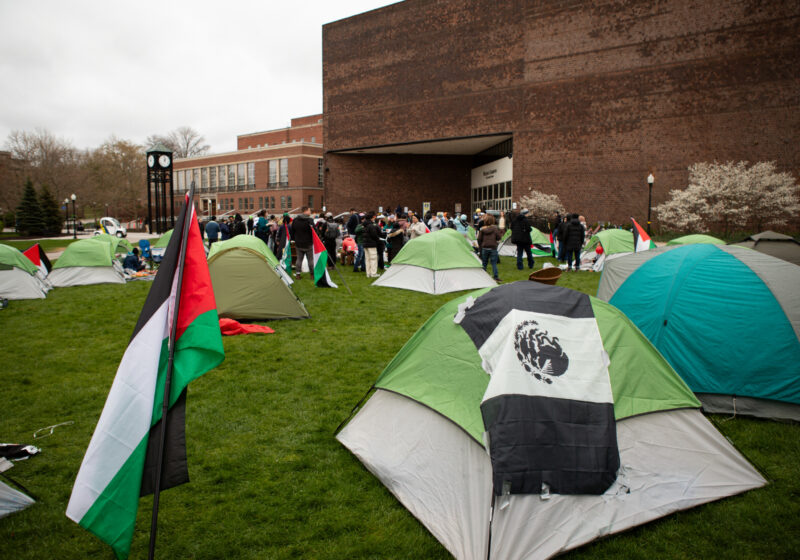The Eastman Philharmonia made national news by refusing to tour the lucrative Chinese market as an act of solidarity to its South Korean musicians, who would have been prevented from performing on political grounds. This made serious news, but it was not the first public international controversy surrounding UR.
It was 1987. Paul Aunent reported for the Campus Times: “Tsuneo Sakai, a Fuji Photo Film Co. employee, initially dropped from UR under pressure from the Eastman Kodak Co. but now invited back to attend, says he will stay put at MIT’s Sloan School of Management. This is the latest development in the Fuji-UR-Kodak affair according to the Associated Press.”
Sakai had originally been accepted to study as an MBA candidate at the Simon School of Business.
But Eastman Kodak — which to this day considers the program at Simon one of its major feeds — exerted enough influence over the admissions department that, upon their discovery that Sakai was employed by Fuji, they rescinded his letter.
Fuji and Kodak were bitter rivals. The Japanese company was rapidly encroaching upon a photography market that had previously been a near-monopoly for Rochester’s corporate powerhouse.
According to a Simon School spokesperson interviewed by the Democrat & Chronicle, “Mr. Sakai’s presence might produce” what the admissions department called “a possible constraint […] on the free exchange of information in the classroom.” Translated, this meant that Kodak feared Sakai would somehow compromise their trade secrets by participating in classes at a school to which he had been legitimately accepted and was willing to travel thousands of miles from home to attend.
The move made national headlines. The New York Times called it “an unusual show of corporate influence, even in the long, close relationship between American business and the nation’s business schools.”
Then-university president Dennis O’Brien vacillated in an interview with the Los Angeles Times, saying that, “We don’t want to be in the position where we’re closing our classrooms, but we don’t want to create a situation that endangers a company’s proprietary strategies.”
The article said the University was “planning to re-examine the close relationship between its graduate business school and Eastman Kodak Co.,” but O’Brien wrote in a memo to students obtained by the LA Times that “the university accepted in good faith the judgment of Kodak about a situation which the company believed to be potentially very harmful.”
Kodak had pledged $10 million to the school earlier that year.
UR students, alumni, and professors nearly universally condemned the action. Larry Maushard wrote in a seething letter to the CT Editor, “I […] would feel like an academic prostitute if I was part of the school’s current administration.” He went on to suggest that the school’s name be changed, not to “Eastman University,” as O’Brien had controversially suggested earlier in his term, but to “the Kodak Trade School.”
Along with Maushard’s, CT printed a letter from professor Michael G. Raymer, chairman of graduate admissions for the optics program, that was hotly critical of the decision, arguing that the cause of the “constraint on the free exchange of information” claimed by the Simon spokesperson “is not Mr. Sakai, but rather the UR itself!”
Robert N. Davis, a UR graduate, said that the scandal “reminded me of the pervasive, self-destructive inferiority complex I saw at the UR.” He claimed that “a truly great school would have the confidence to know that if Kodak did withdraw its students from the Simon School, [Kodak] would lose far more than the University.”
This gets to the heart of the controversy. Davis and many others at the time believed the University had conceded to pressure from a major corporate sponsor instead of sticking to its guns and maintaining integrity in the admissions process.
When the school ultimately reversed its decision and invited Sakai back, it was too little, too late. Clearly insulted, he stayed at MIT, and UR lost not only face but also a promising student who would have brought valuable perspective as a rare Fuji employee in Kodak-dominated classes.
Instead, Fuji went on to introduce a photography scholarship at RIT months later.
The University displayed what many saw as a strange melding of cowardice and hubris, first in rescinding Sakai’s acceptance, then in flip-flopping back on the original flip-flop and expecting the Fuji employee to abandon an even more prestigious MBA program and return to a school that had already publicly disrespected him. Concerned about not angering Kodak, UR ended up angering its sponsors, its students, and its faculty at the same time.
Both the “Fuji-UR-Kodak affair” and the recent cancellation of the Eastman tour in China were cases where the University’s refusal to advocate for its students instead of its own financial interests from the get-go led to consequences for its public image.
Sure, both decisions were eventually reversed, but the controversies that followed them remained. Under pressure, administrators ultimately did the right thing, but we remember that they didn’t do it first.
